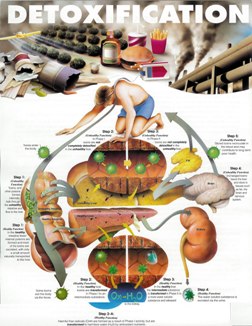Heavy Metals and their effect on our health
Common heavy metals and their typical sources.

There are many heavy metals that people are exposed to regularly without realizing it. Mercury, cadmium, and aluminum, among others, are able to embed themselves into our central nervous systems and bones, bio-accumulating for years until we start to suffer acute health problems from heavy metal poisoning. Levels are up to several thousand times higher than in primitive man. In my clinical experience, everyone has excessive amounts of some or all of the toxic metals.
Toxic metals replace nutrient minerals in enzyme binding sites. When this occurs, the metals inhibit, overstimulate or otherwise alter thousands of enzymes. An affected enzyme may operate at 5% of normal activity. This may contribute to many health conditions. Toxic metals may also replace other substances in other tissue structures. These tissues, such as the arteries, joints, bones and muscles, are weakened by the replacement process.
Toxic metals may also simply deposit in many sites, causing local irritation and other toxic effects. They may also support development of fungal, bacterial and viral infections that are difficult or impossible to eradicate until this cause is removed.
LEAD
Lead has been called the horror mineral because it is associated with violence, lowered IQ, ADD, ADHD and many neurological problems. Another widely distributed toxic metal due to its many uses in industry.
Pesticides used on fruits, vegetables and many other foods may contain arsenic, lead, copper, mercury and other toxic metals. Lead was added to gasoline until the 1970s when lead-free gas replaced it. The new gasoline has manganese in it instead of lead. Old house paint, current paint used on ships of all sizes, lubricants, medications, cosmetics such as lipstick and others, inks, and perhaps other products may contain lead. Entire books have been written about lead toxicity, which causes hundreds of symptoms from anemia to death.
Typical sources: Auto exhaust; Industrial smelters and paint factories; Lead water pipes; Industrial pollution in the water; Pesticide runoff; Acid rain be it industrial or volcanic; Roof paint through the catchment system; Lead paint on children's cribs which they eat because it tastes sweet; Cigarettes due to lead arsenate as an insecticide; Insecticides/fungicides; Burning newspapers due to the lead in the ink; Soldered items; Gardens near a main road; Children playing near main roads; Jogging on main roads; Commercial baby milk; Industrial materials such as nails, solder, plaster, putty; Shellfish; Gasoline; Bullets; Organ meats; Dog food; Cosmetics, Dolomite; Paper clips; Cooking utensils; Hair colorings; Wines; Leaded toothpaste tubes.
Typical symptomes: Constipation; Vomiting; Learning difficulties; Mental retardation; Hyperactivity; Vertigo; Gout, arthritis; kidney damage; Birth defects; Coordination inabilities; Muscle weakness; Anorexia; Seizures; Cirrhosis of the liver; Metallic taste sensations; Thyroid dysfunction; Nausea; Diarrhea; Difficulty in concentration; Confusion; Restlessness; Insomnia; Muscle aches; Fatigue; Pituitary damage; Impotence/sterility; Tremors; Degeneration of motor neurons; Schizophrenic-like behavior; Growth problems in long bones; Cataracts; Headaches; Anemia; Lead-lined gums.
CADMIUM
Cadmium has been called the pseudo-macho or the violent element. Like lead, it is an older male mineral that is associated with macho behavior, violence and horror. Male and female sexual fluids are rich in zinc, and when one loses too much of these, cadmium from the environment seems to replace the zinc in the body. Thus, people who have orgasms more than once a week tend to accumulate cadmium, probably because it replaces zinc in the male testicles and even in women's ovaries.
Cadmium is widespread in the air, as it is used in brake linings of cars. It is also used in metal plating as it is a very hard substance. Cigarette smoke and marijuana smoking can contribute to cadmium toxicity. Cadmium toughens the tissues and hardens the arteries. Cadmium helps some people to act more tough and manly. Unfortunately, it is also a deadly toxic metal associated with heart disease, cancers of all kind, kidney disease, diabetes and other health problems.
Typical symptomes: Emphysema; Hypertension; Kidney damage; Arteriosclerosis; Abdominal cramps; Colic; Diarrhea; Slow healing acne; Nausea/vomiting; Liver disease; Anemia.
Sources: Cigarettes; Fertilizers; Water pipes; Soft drink dispensers; Coal burning; Refined foods.
MERCURY
Mercury and others from the sea. Mercury may be called the mad hatters mineral. People who made raccoon skin hats in the mid 1800s in America and Europe developed mercury toxicity after a few years from rubbing mercury on felt to soften it. They became mentally and emotionally deranged in many cases.
Fish, especially those caught near the coast or in contaminated streams or lakes, are universally contaminated. Mercury is found today in ALL FISH, bar none. Even small fish, which used to be safe, are not any more. This is sad as fish is otherwise an excellent food.
As a result, the only fish I recommend are very small fish, and the best is sardines because of their content of omega-3 fatty acids and vitamin D, along with calcium, selenium, RNA, DNA and many other vital nutrients. The omega-3 fatty acids and vitamin D are almost universally deficient in modern diets and are important for everyone.
Sardines in the can are fine. All other fish should be avoided, except perhaps occasional small fish like sole, smelt, anchovies or herring.
Large fish concentrate mercury a million times or more. The federal government recently issued a warning that pregnant and lactating women should avoid tuna, shark, king mackerel and other large fish. I recommend everyone avoid these fish! Shellfish and bottom feeders in particular contain excessive cadmium, mercury and other toxic metals. Please avoid all shellfish, as their toxic metal levels are incredible at times. This is why many people are "allergic" to them.
Typical symptomes: Tremors; Birth defects; Kidney damage; Nausea; Loss of hearing or vision; Gingivitis; Vertigo; Nervousness; Fatigue; Chromosome damage; Insanity; Abdominal pain; Vomiting; Mental retardation; Tooth loss; Headaches; Skin eruptions.
Typical sources: Dental fillings; Pesticides/ fungicides; Pollution; Fish; Adhesives; Fabric softeners; Drugs; Coal burning; Cosmetics; Water-based paints; Chemical fertilizers; White powdered laxatives.
ALUMINUM
Aluminum. Aluminum is called the soft in the head mineral because it is associated with memory loss and dementias. All types of salt contain some aluminum. Table salt often has aluminum added as an anti-caking agent and should never be eaten. Sea salt is better but contains some aluminum as well.
Beverages in aluminum cans or food cooked in aluminum may contain elevated levels of aluminum. Ceramic plates and cookware from other nations often contain leaded glazes that come off onto the food. Anti-perspirants all contain aluminum compounds. Use an old-fashioned deodorant instead, or put some liquid soap like Dr. Bronner's peppermint soap under your arms instead.
Typical symptomes: Digestive disorders; Colic; Gastritis; Dementia; Alzheimer's; Seizures; Motor and behavioral dysfunction; Skin rash; Headache.
COPPER
Typical symptomes: Mental disorders; Anemia; Arthritis/rheumatoid arthritis; Hypertension; Nausea/vomiting; Hyperactivity; Schizophrenia; Insomnia; Autism; stuttering; Copper deposits in kidney, liver, brain, eyes; Postpartum psychosis; Inflammation and enlargement of liver; Heart problems; Cystic fibrosis.
Typical Sources: Copper water pipes; Copper water heaters; Meats using copper sulfate as a growth enhancer; Frozen greens and canned greens using copper to produce an ultra-green color; Zinc deficiency; Alcoholic beverages from copper brewery equipment; Instant gas hot water heaters; Hormone pills; Pesticides. Insecticides; fungicides; Copper jewelry; Copper cooking pots.
ARSENIC
Arsenic is caledl the slow death mineral. Its symptoms are vague, and it was used to kill people because it is colorless and tasteless so it was added to food and slowly killed people.
Today arsenic is still a common toxin. It may be added in up to 70% of chickens in their feed as Roxsarone and perhaps in other additives that are still permitted by the FDA and USDA in America. Europe has banned arsenic in chicken feed. It gets into commercial eggs, all pig products such as pork, ham, bacon and lard, and into most US drinking water supplies as it leaches into the soil from farming and livestock operations. Organic chicken and eggs should be better. Avoid all pig products for other reasons and this one, too.
Arsenic is used in pesticides and, as a result, may be found in commercial wines, beers, fruits, vegetables, rice and other foods. Once again, organically grown should be better.
Nickel
This is called the depression and suicide mineral, as it is associated with these feelings and symptoms. It is a particularly deadly toxic metal. It is found in large quantity, sadly, in some older metal or even ceramic dental fixtures such as crowns and some wires used in bridges and braces. Be very careful about this because nickel can contribute to cancer and other horrible problems. Nickel in much smaller quantity in hydrogenated oils found in commercial peanut butter, margarines including soy margarine and vegetable shortening. Cadmium used as catalysts.
Details on Khabir's Heavy Metal Detoxification Program














